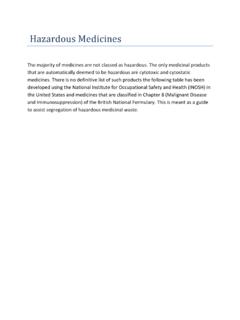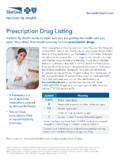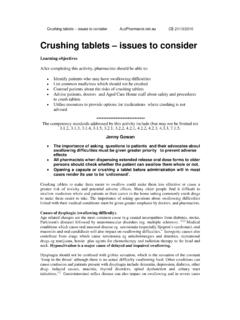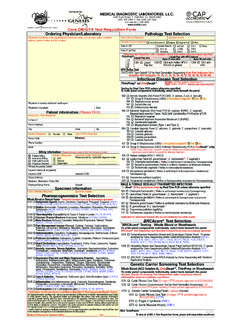Transcription of DRUG NAME: Fluorouracil - BC Cancer
1 Fluorouracil BC Cancer Agency Cancer drug Manual Page 1 of 11 Fluorouracil Developed: September 1994 Revised: June 2006 Limited revision: 1 September 2015 drug name : Fluorouracil SYNONYM(S): 5-FU, 5- Fluorouracil , NSC-19893 COMMON TRADE name : generic available, ADRUCIL , EFUDEX CREAM CLASSIFICATION: antimetabolite Special pediatric considerations are noted when applicable, otherwise adult provisions apply. MECHANISM OF ACTION: Fluorouracil is an analog of the pyrimidine uracil and thus acts as a pyrimidine There are three possible mechanisms of First, the Fluorouracil metabolite fluorodeoxyuridine monophosphate (FdUMP) competes with uracil to bind with thymidylate synthetase (TS) and the folate This results in decreased thymidine production and therefore decreased DNA synthesis and repair, and ultimately decreased cell proliferation.
2 Leucovorin (formyltetrahydrofolate, formyl-FH4) enhances Fluorouracil by stabilizing the binding of FdUMP to TS. Second, the Fluorouracil metabolite fluorodeoxyuridine triphosphate (FdUTP) is incorporated into DNA thus interfering with DNA Finally, the Fluorouracil metabolite fluorouridine-5-triphosphate (FUTP) is incorporated into RNA in place of uridine triphosphate (UTP), producing a fraudulent RNA and interfering with RNA processing and protein Fluorouracil is cell-cycle specific (S-phase).3 PHARMACOKINETICS: Interpatient variability variations in dihydropyrimidine dehydrogenase (DPD) activity result in differences in toxicity5 (refer to the Dihydropyrimidine dehydrogenase (DPD) deficiency paragraph following the Side Effect table for more information) Oral Absorption erratic; 28-100% Distribution approximately 22% of total body water; penetrates extracellular fluid and third space fluids ( , malignant effusions and ascitic fluid) cross blood brain barrier?
3 Yes volume of distribution6 8-11 L/m2 plasma protein binding7 10% Metabolism activated in target cells; 80% degraded in liver by DPD6 active metabolite(s) FdUMP, FUTP, and FdUTP inactive metabolite(s) dihydrofluorouracil Excretion 60-80% excreted as respiratory CO2; 2-3% by biliary system urine <10% as intact drug6 terminal half life IV bolus: 8-14 min (see also nonlinear pharmacokinetics in clearance below) clearance IV bolus: 350-850 mL/min/m2; dependent on dose, schedule, and route of administration; nonlinear pharmacokinetics due to saturable degradation6; interference with Fluorouracil degradation markedly prolongs its half-life6 continuous infusion: clearance increases Ethnicity DPD deficiency: caucasian (3-5%); African-American Adapted from standard references9,10 unless specified otherwise.
4 Fluorouracil BC Cancer Agency Cancer drug Manual Page 2 of 11 Fluorouracil Developed: September 1994 Revised: June 2006 Limited revision: 1 September 2015 USES: Primary uses: Other uses: *Actinic keratoses (topical Fluorouracil )11 Cervical cancer4 *Bladder Cancer Esophageal cancer4 *Breast Cancer Renal cell cancer4 *Colorectal Cancer Skin Cancer , Bowen's disease (topical Fluorouracil )12 *Gastric Cancer Skin Cancer , squamous cell (topical Fluorouracil )12 *Head and neck Cancer *Ovarian Cancer *Pancreatic Cancer *Prostate Cancer *Skin Cancer , basal cell (topical Fluorouracil )11 *Health Canada approved indication SPECIAL PRECAUTIONS: Contraindicated in patients who have a history of hypersensitivity to Fluorouracil or any component of the Relatively contraindicated in patients who have a known hypersensitivity to Dihydropyrimidine dehydrogenase (DPD) deficiency may result in life-threatening or fatal toxicity in patients receiving Fluorouracil via parenteral or topical For more information refer to the Dihydropyrimidine dehydrogenase (DPD) deficiency paragraph following the Side Effect table.
5 Nonlinear pharmacokinetics result in unpredictable plasma concentrations and toxicity at high Elderly patients are at increased risk for developing toxicities, likely due to decreased bone marrow Female patients are at increased risk for developing ,14,15 Use with caution in patients who are receiving radiation or who have received high-dose pelvic radiation and in patients previously treated with alkylating These patients may have bone marrow suppression. Carcinogenicity: Not yet Mutagenicity: Fluorouracil has been shown to be mutagenic in some bacterial It is clastogenic in mammalian in vitro and in vivo chromosome tests. Fertility: The effects of Fluorouracil on fertility have not been Pregnancy10: FDA Pregnancy Category D.
6 There is positive evidence of human fetal risk, but the benefits from use in pregnant women may be acceptable despite the risk ( , if the drug is needed in a life-threatening situation or for a serious disease for which safer drugs cannot be used or are ineffective). Breastfeeding is not recommended due to the potential secretion into breast SIDE EFFECTS: The table includes adverse events that presented during drug treatment but may not necessarily have a causal relationship with the drug . Because clinical trials are conducted under very specific conditions, the adverse event rates observed may not reflect the rates observed in clinical practice. Adverse events are generally included if they were reported in more than 1% of patients in the product monograph or pivotal trials, and/or determined to be clinically important16.
7 When placebo-controlled trials are available, adverse events are included if the incidence is > 5% higher in the treatment group. Fluorouracil BC Cancer Agency Cancer drug Manual Page 3 of 11 Fluorouracil Developed: September 1994 Revised: June 2006 Limited revision: 1 September 2015 ORGAN SITE SIDE EFFECT Clinically important side effects are in bold, italics allergy/immunology anaphylaxis (rare)3 generalized allergic reactions (rare)3 blood/bone marrow/ febrile neutropenia myelosuppression*: onset: 7-10 days; nadir: 14 days; recovery: 30 days cardiovascular (arrhythmia) arrhythmias cardiotoxicity* (< 8%)17; see paragraph following Side Effects table chest pain (< 1%); ranging from mild angina to crushing pain CHF (rare)3 hypotension (< 1%) constitutional symptoms somnolence (< 1%) dermatology/skin extravasation hazard: irritant9,10,18 For more information on topical application see paragraph after this table.
8 Alopecia (> 10%) dermatitis* (>10%) dry skin and fissuring (1-10%) nail changes (< 1%); banding or loss of nails palmar-plantar erythrodysesthesia (PPE)* (<1%); see paragraph following Side Effects table photosensitivity (< 1%) vein hyperpigmentation (< 1%); proximal to injection sites gastrointestinal emetogenic potential19: rare (< 10%) anorexia (> 10%) diarrhea* (> 10%) esophagitis (>10%) heart burn (>10%) nausea (< 10%) stomatitis* (> 10%) epithelial ulceration (1-10%) vomiting (< 10%)19 hemorrhage GI bleeding hepatic biliary sclerosis6 hepatic toxicity (< 1%) neurology acute cerebellar ataxia (< 1%); increased with high doses or intensive regimens; see paragraph following Side Effects table neurotoxicities* (< 1%) ocular/visual excessive lacrimation ocular toxicities*; see paragraph following Side Effects table Fluorouracil BC Cancer Agency Cancer drug Manual Page 4 of 11 Fluorouracil Developed: September 1994 Revised: June 2006 Limited revision: 1 September 2015 ORGAN SITE SIDE EFFECT Clinically important side effects are in bold, italics pain headache (< 1%) pulmonary dyspnea (< 1%) Adapted from standard references9,10 unless specified otherwise.
9 *Severity varies with route of administration, refer to the paragraph Dosing schedule and toxicity . Dosing schedule and toxicity: The spectrum of toxicity associated with Fluorouracil treatment varies with dose, schedule, route of administration, and whether the Fluorouracil is being used with a biochemical The most commonly seen toxicities when standard doses are administered in the following schedules and routes are: monthly bolus administration20: myelosuppression can be dose-limiting daily bolus administration for 5 days20: diarrhea can be dose-limiting; myelosuppression, stomatitis, ocular, and dermatitis6 continuous infusion given over 24 hours to several weeks20: diarrhea, and stomatitis can be dose-limiting; myelosuppression, dermatitis, PPE, neurologic, ocular, and cardiotoxicity10 weekly bolus administration20: diarrhea can be dose-limiting; myelosuppression, stomatitis,6 and ocular21 topical daily6: local inflammation In the event of a 5FU overdose, appropriate and timely measures to anticipate and implement supportive management of patients at risk for severe 5FU toxicity should be implemented.
10 Refer to BCCA Management Guideline: Management of 5- Fluorouracil (5FU) infusion overdose at the BCCA (Interim Guidance) ( Fluorouracil Overdose). Oral cryotherapy with bolus doses of Fluorouracil : It is recommended that patients receiving bolus Fluorouracil undergo 30 minutes of oral cryotherapy to decrease the incidence and severity of Fluorouracil -induced The incidence can be reduced by 50%.23 Starting 5 minutes before the injection, the patient is asked to place ice chips into their mouth and swish for 30 minutes, replenishing the ice as it melts. This may cause numbness or headaches which subside quickly. This cooling of the oral cavity leads to vasoconstriction resulting in a lower concentration of Fluorouracil reaching the oral Oral cryotherapy is not used for infusional Fluorouracil as this would be very inconvenient.

















